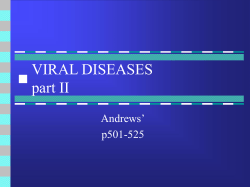
Behçet or not Behçet ? Dermatology quiz Camille Frances Hôpital Tenon
Behçet or not Behçet ? Dermatology quiz Camille Frances Hôpital Tenon France camille.frances@tnn.aphp.fr Case 1 Previously healthy 19 year old woman Acute painful genital ulcers with urinary retention due to pain Odynophagia for 10 days, intense fatigue No previous sexual contact At physical examination fever 40°C pharyngeal oedema lymphadenopathies Laboratory investigations Blood count: increased lymphocytes 6500/ml Negative bacterial cultures from blood, ulcerations, pharynx Negative viral culture for HSV from vulvar ulcerations Negative serologic tests for CMV, HIV, viral hepatitis B and C, syphilis, toxoplasmosis, p24 antigenemia Transaminases x2N Vulvar biopsy: non specific inflammatory dermal infiltrate What is the diagnosis ? Diagnosis Acute Genital Ulcers of Lipschütz Follow At day 10, positive anti-EBV capsid antibodies (IgM) At day 18, positive anti-EBV capsid antibodies (IgM and IgG) Negative anti-EBV nuclear antibodies (IgM or IgG) EBV serum load : 425 copies/ml Acute Genital Ulcers of Lipschütz with EBV primary infection Acute Genital Ulcers of Lipschütz Fahri D et al. Arch Dermatol 2009; 145: 38-45 Acute genital ulcers with the absence of further relapses No past history of recurrent aphthae Frequently young girls <20 year old without sexual activity Bilateral vulvar ulcers with a kissing pattern Spontaneous healing (but frequently antibiotic and antiviral therapy) Duration of lesions < 30 days Fever, myalgias Mild liver abnormalities Associated infections EBV primary infection (1/3) Salmonellosis Mycoplasmas HIV, Mumps Cytomegalovirus Influenza A Toxoplasma gondii Lyme disease Finch JJ et al Jama Dermatol 2014 on line Not precised in many cases Case 2 Previously non smoker, healthy, French, 21 yearold man Without past medical history Painful lesions on the lower right side vestibule for 1 month and on penis for 15 days No general manifestation, no skin lesion Absence of ocular or gastrointestinal complaint What to do during clinical examination for diagnosis ? Aphthae in chronic inflammatory bowel disease Incidence : 5 to 30% Chronic ulcerative colitis > Crohn’s disease Unipolar, bipolar or tripolar (mouth, genitalia, anus) In less than 10% of cases, parallel evolution with gastrointestinal involvement May be associated with specific granulomatous lesions of Crohn’s disease May precede by several years the gastrointestinal involvement Case 3 French 55 year old man Past history: chronic sinusitis from 3 years; Atherosclerosis with transient ischemic attacks 2 years before (heavy smoker) Treatment: aspirin 100mg/d, nicorandil 30mg/d, rosuvastatine 10mg/d for 2 years + antibiotics and steroids during flares of sinusitis Jugal ulceration from 1 month Fever, purpuric lesions on the legs What possible diagnoses ? Behcet’s disease Crohn’s disease Granulomatosis with polyangiitis (Wegener) Nicorandil-induced mucosal ulceration and purpura What possible diagnoses ? Behcet’s disease : Possible but unlikely Too old for Behcet’s disease onset Purpura: rarely an initial manifestation Crohn’s disease : Possible but unlikely Granulomatosis with polyangiitis : Yes Normal anus No gastrointestinal complaint Sinusitis, Oral ulceration Purpura Fever Nicorandil-induced dermatologic lesions: Unlikely Jugal ulceration may be induced by nicorandil Onset of purpuric lesions is too late as nicorandil is taken for 2 years Granulomatosis with polyangiitis Biopsy of purpuric lesions : leukocytoclastic vasculitis Biopsy of jugal ulceration: non specific inflammation Positive ANCA (Proteinase 3 type) Oral ulcers in granulomatosis with polyangiitis Frequent : 10% to 50% of cases Unlike aphthae, persistent and not recurrent Number and location highly variable (cheeks, tongue, floor of the mouth, lips, palate, gingivae, tonsils, posterior palate) Pathologic findings usually nonspecific : acute and chronic inflammation, rarely: extravascular granuloma Thank you
© Copyright 2025





















